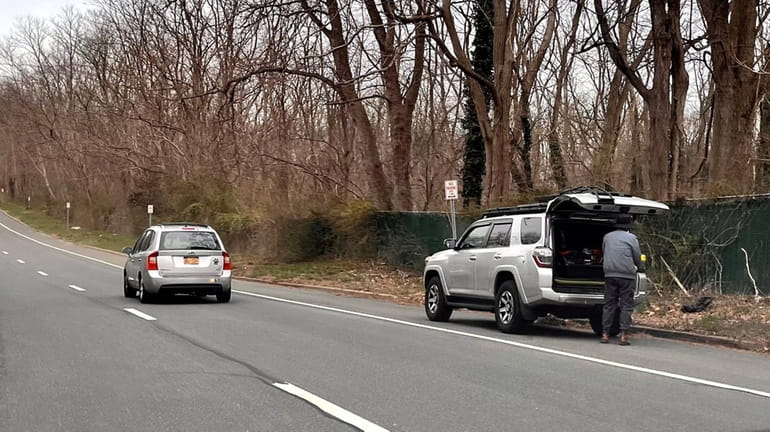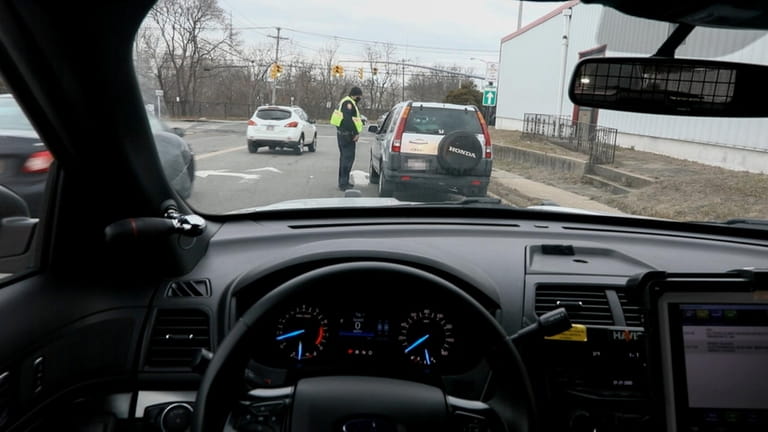New NYS law mandates drivers move over for all disabled vehicles in roadway

A vehicle stopped on the North Service Road of the Long Island Expressway in Dix Hills. Credit: Newsday
Drivers must start taking more precautions — moving over for disabled vehicles or slowing down if it’s unsafe to change lanes — under a state law that takes effect Wednesday.
The law — passed unanimously in June by the State Legislature and signed in September by Gov. Kathy Hochul — extends to all vehicles the existing protections for emergency responders, highway maintenance workers and tow-truck drivers.
“It’s a common-sense measure that will make our roads safer for people that have a broken-down vehicle,” state Assemb. Ken Zebrowski (D-New City), a chief sponsor of the legislation, said in an interview. “You know, I think common sense already dictates that if you see somebody on the side of the road, that you move over to give them a little bit of a space, but unfortunately we’ve seen fatalities over the years.”
The law requires that, if it is unsafe to make a lane change, a motorist must “slow down to a reasonable speed.”
Said Zebrowski: “Certainly, if there’s a car next to you and you can’t do so safely, you’re not expected to.”
The law amends the Vehicle and Traffic Law by expanding how motorists must exercise “due care.”
Violating the law carries two license points and a maximum fine of $150 for a first offense, according to Walter McClure, a spokesman for the state Department of Motor Vehicles. (Fines go up for certain subsequent violations.)
Zebrowski said the law’s requirement is triggered when there is a disabled vehicle in the road, or on the side of a parkway or other controlled-access highway — parked, stopped or standing — regardless of whether the vehicle has its hazard lights flashing.
“Look, we don’t want people to get ticketed; we just want them to move over. Make it a little bit safer for folks on the side of the road. It just makes sense,” he said. “It’s both a courtesy but it’s also, if somebody has a flat tire or God forbid they stop the car and a kid gets out of the back seat and is a little bit absent-minded.”
The law covers disabled vehicles in any part of the roadway, not just on the shoulder, according to state Sen. Lea Webb (D-Binghamton), a chief sponsor of the legislation. Wherever a vehicle is disabled, the law is an attempt to prevent injuries and deaths for those involved, she said.
“You could be driving, and you get a flat tire, or you have a nonvehicle-related emergency and you pull over, you shouldn’t have your life in danger,” she said.
Once the law goes into effect, New York will become the 22nd state — joining Arizona, Colorado, Connecticut, Delaware, Florida, Illinois, Indiana, Iowa, Maine, Maryland, Minnesota, New Jersey, North Dakota, Oklahoma, Oregon, Pennsylvania, Rhode Island, South Dakota, Tennessee, Utah and Virginia — with a move-over law covering all stopped vehicles, according to Lee Howell, the AAA’s state relations manager.
In some states, failing to move over could be punishable by jail, according to a National Highway Traffic Safety Administration tip sheet.
In 2011, Arizona became the first state to include all vehicles in its move-over law, Howell said.
But the nation’s first move-over law of any kind — covering just emergency scenes — was passed in 1996 in South Carolina following a paramedic’s roadside death. By 2012, every state had a move-over law for first responders, and by 2017, every one of the laws had been extended to cover tow trucks, Howell said.
New York’s law is less specific than in some states, such as Washington and Florida, which tell motorists how slow they must go if moving over isn’t safe.
The AAA Foundation for Traffic Safety is researching the extent to which motorists comply with move-over laws, Howell said. The foundation found that 17% of motorists are unaware of their state’s move-over law.
Between 2016 and 2020, 37 people were killed in New York State in crashes while outside a disabled vehicle, with five in Nassau — the most of any county in the state — and two in Suffolk, according to Howell, citing National Highway Traffic Safety Administration data.
The AAA cited a March 2021 study in the journal Accident Analysis & Prevention that nearly 300 motorists nationwide are struck and killed roadside annually, according to a memorandum by AAA contained in a legislative folder filed with the New York State Archives.
In a memorandum in support of the legislation, Webb wrote that despite the existing move-over law being effective in protecting emergency responders and other personnel such as tow-truck drivers, “Unfortunately, there are still tragedies each year involving other motorists that are killed or seriously injured while stopped on the shoulder to attend to an emergency.”
In an email, the Suffolk County police press office wrote Thursday that the department has enforced the move-over law in its current interaction and plans to expand enforcement in accordance with the new law, both in the regular course of patrols and with details dedicated to finding and ticketing violators.
Nassau County cops on patrol will proactively look for violators, according to a statement from the police commissioner provided by spokesman Det. Lt. Richard LeBrun. The NYPD didn’t respond to an emailed inquiry.
Drivers must start taking more precautions — moving over for disabled vehicles or slowing down if it’s unsafe to change lanes — under a state law that takes effect Wednesday.
The law — passed unanimously in June by the State Legislature and signed in September by Gov. Kathy Hochul — extends to all vehicles the existing protections for emergency responders, highway maintenance workers and tow-truck drivers.
“It’s a common-sense measure that will make our roads safer for people that have a broken-down vehicle,” state Assemb. Ken Zebrowski (D-New City), a chief sponsor of the legislation, said in an interview. “You know, I think common sense already dictates that if you see somebody on the side of the road, that you move over to give them a little bit of a space, but unfortunately we’ve seen fatalities over the years.”

A Nassau County police officer during a traffic stop on Jan. 27, 2021. Credit: Chris Ware
The law requires that, if it is unsafe to make a lane change, a motorist must “slow down to a reasonable speed.”
WHAT TO KNOW
- Starting March 27, motorists in New York must move over for any vehicle on the side of a parkway or other controlled-access highway.
- The new law going into effect broadens existing rules protecting emergency responders, tow-truck drivers and others.
- A violation can mean two driver’s license points and a maximum fine of $150 for a first offense.
Said Zebrowski: “Certainly, if there’s a car next to you and you can’t do so safely, you’re not expected to.”
The law amends the Vehicle and Traffic Law by expanding how motorists must exercise “due care.”
Violating the law carries two license points and a maximum fine of $150 for a first offense, according to Walter McClure, a spokesman for the state Department of Motor Vehicles. (Fines go up for certain subsequent violations.)
Zebrowski said the law’s requirement is triggered when there is a disabled vehicle in the road, or on the side of a parkway or other controlled-access highway — parked, stopped or standing — regardless of whether the vehicle has its hazard lights flashing.
“Look, we don’t want people to get ticketed; we just want them to move over. Make it a little bit safer for folks on the side of the road. It just makes sense,” he said. “It’s both a courtesy but it’s also, if somebody has a flat tire or God forbid they stop the car and a kid gets out of the back seat and is a little bit absent-minded.”
The law covers disabled vehicles in any part of the roadway, not just on the shoulder, according to state Sen. Lea Webb (D-Binghamton), a chief sponsor of the legislation. Wherever a vehicle is disabled, the law is an attempt to prevent injuries and deaths for those involved, she said.

A box truck plowed into the Eagle Avenue bridge at Exit 18 on the Southern State Parkway on April 6, 2019. Credit: Lou Minutoli
“You could be driving, and you get a flat tire, or you have a nonvehicle-related emergency and you pull over, you shouldn’t have your life in danger,” she said.
Once the law goes into effect, New York will become the 22nd state — joining Arizona, Colorado, Connecticut, Delaware, Florida, Illinois, Indiana, Iowa, Maine, Maryland, Minnesota, New Jersey, North Dakota, Oklahoma, Oregon, Pennsylvania, Rhode Island, South Dakota, Tennessee, Utah and Virginia — with a move-over law covering all stopped vehicles, according to Lee Howell, the AAA’s state relations manager.
In some states, failing to move over could be punishable by jail, according to a National Highway Traffic Safety Administration tip sheet.
In 2011, Arizona became the first state to include all vehicles in its move-over law, Howell said.
But the nation’s first move-over law of any kind — covering just emergency scenes — was passed in 1996 in South Carolina following a paramedic’s roadside death. By 2012, every state had a move-over law for first responders, and by 2017, every one of the laws had been extended to cover tow trucks, Howell said.
New York’s law is less specific than in some states, such as Washington and Florida, which tell motorists how slow they must go if moving over isn’t safe.
The AAA Foundation for Traffic Safety is researching the extent to which motorists comply with move-over laws, Howell said. The foundation found that 17% of motorists are unaware of their state’s move-over law.
Between 2016 and 2020, 37 people were killed in New York State in crashes while outside a disabled vehicle, with five in Nassau — the most of any county in the state — and two in Suffolk, according to Howell, citing National Highway Traffic Safety Administration data.
The AAA cited a March 2021 study in the journal Accident Analysis & Prevention that nearly 300 motorists nationwide are struck and killed roadside annually, according to a memorandum by AAA contained in a legislative folder filed with the New York State Archives.
In a memorandum in support of the legislation, Webb wrote that despite the existing move-over law being effective in protecting emergency responders and other personnel such as tow-truck drivers, “Unfortunately, there are still tragedies each year involving other motorists that are killed or seriously injured while stopped on the shoulder to attend to an emergency.”
In an email, the Suffolk County police press office wrote Thursday that the department has enforced the move-over law in its current interaction and plans to expand enforcement in accordance with the new law, both in the regular course of patrols and with details dedicated to finding and ticketing violators.
Nassau County cops on patrol will proactively look for violators, according to a statement from the police commissioner provided by spokesman Det. Lt. Richard LeBrun. The NYPD didn’t respond to an emailed inquiry.

